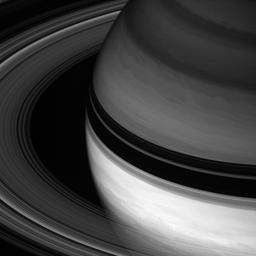
|
Contrast Across the Shadows
- Click the image above for a larger view
- Full-Res JPEG (1020 x 1020) (67.4 kB)
- Full-Res TIFF (1020 x 1020) (1.0 MB)
Caption:
Saturn's rings sweep around the planet, throwing their dark shadows onto the northern hemisphere.
The equatorial region is generally brighter than the rest of the planet in Cassini spacecraft views, but the contrast is often striking in monochrome views like this, taken in the infrared part of the spectrum at wavelengths sensitive to methane absorption in the planet's atmosphere. (Compare, for example, PIA08392 and PIA07669 .)
This view looks toward the unilluminated side of the rings from about 24 degrees above the ringplane.
Background Info:
The Cassini-Huygens mission is a cooperative project of NASA, the European Space Agency and the Italian Space Agency. The Jet Propulsion Laboratory, a division of the California Institute of Technology in Pasadena, manages the mission for NASA's Science Mission Directorate, Washington, D.C. The Cassini orbiter and its two onboard cameras were designed, developed and assembled at JPL. The imaging operations center is based at the Space Science Institute in Boulder, Colo.
For more information about the Cassini-Huygens mission visit http://saturn.jpl.nasa.gov/home/index.cfm . The Cassini imaging team homepage is at http://ciclops.org .
Cataloging Keywords:
| Name | Value | Additional Values |
|---|---|---|
| Target | Saturn Rings | |
| System | Saturn | |
| Target Type | Ring | |
| Mission | Cassini-Huygens | |
| Instrument Host | Cassini Orbiter | |
| Host Type | Orbiter | |
| Instrument | Imaging Science Subsystem (ISS) | |
| Detector | ||
| Extra Keywords | Atmosphere, Grayscale, Infrared, Methane, Shadow, Wave | |
| Acquisition Date | ||
| Release Date | 2008-01-17 | |
| Date in Caption | ||
| Image Credit | NASA/JPL/Space Science Institute | |
| Source | photojournal.jpl.nasa.gov/catalog/PIA09817 | |
| Identifier | PIA09817 | |
